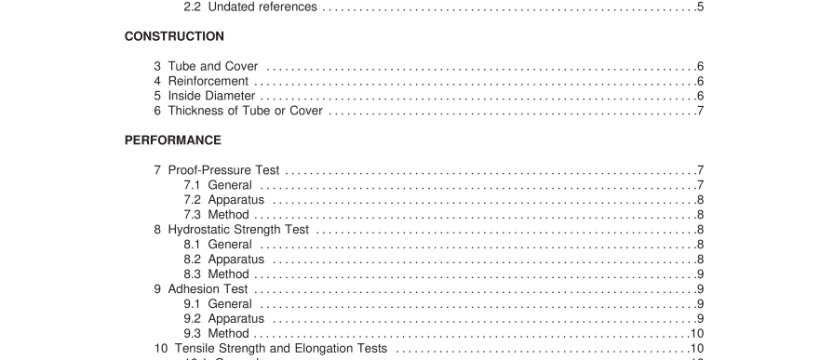UL 21-2007 pdf download.LP-Gas Hose.
7.2 Apparatus 7.2.1 Hydrostatic pressure may be applied by means of a hand- or power-operated pump or an accumulator system capable of increasing the pressure in the hose at a rate of not less than 300 psig (2070 kPa) nor more than 1 000 psig (6900 kPa) per minute. All pressures are to be measured with a calibrated pressure gauge. 7.3 Method 7.3.1 Samples are to consist of at least one full length [nominally 50 ft (1 5.2 m)] of each size of hose. 7.3.2 By means of couplings or temporary test fittings, one end of the hose is to be connected to the source of water or other acceptable test liquid and the other end closed with a fitting provided with a pet cock for the escape of air while the hose is being filled with liquid. The hose is to be placed on a test surface so as to lie straight and without twist. 7.3.3 With the pet cock open, the test liquid is to be admitted through the hose gradually until all of the air has been expelled and the hose is completely filled. The pet cock is then to be closed and the pressure in the hose is to be increased at a rate of not less than 300 psig (2070 kPa) nor more than 1 000 psig (6900 kPa) per minute until the required test pressure is reached. While the pressure is being increased, the hose is to be carefully examined for leakage and other defects. When the test pressure has been reached, it is to be held at 5 min and the hose checked for leakage or ballooning. 8 Hydrostatic Strength Test 8.1 General 8.1 .1 A hose shall withstand a hydrostatic pressure of 1 750 psig (1 2,1 00 kPa) without leakage, ballooning, or rupture. 8.2 Apparatus 8.2.1 The apparatus for this test is to be the same as specified for the Proof-Pressure Test, Section 7, except that instead of the test table an enclosure is to be used to protect the operator.
8.3 Method 8.3.1 A sample is to consist of a 3-ft (0.9 m) section cut from the length of hose previously subjected to the Proof-Pressure Test, Section 7. 8.3.2 The hose sample, while lying straight, is to be connected to the pump and filled with the test liquid, leaving the pet cock open to allow the air to escape. The pet cock is then to be closed and the pressure in the hose is to be increased at a uniform rate of approximately 1 000 psig (6900 kPa) per minute until the required test pressure of 1 750 psig (1 2,1 00 kPa) has been reached. 9 Adhesion Test 9.1 General 9.1 .1 For 3/8-in (91 5 mm) size hose and smaller, the adhesion between the cover and the reinforcement, between the tube and the fabric reinforcement, and between the plies of fabric reinforcement shall be such that the rate of separation of a ring-shaped specimen, 1 in (25.4 mm) in width, is not greater than 1 in per min with a weight of 8 lbs (3.6 kg) for the adhesion determinations between the cover and the reinforcement and between the tube and the reinforcement and with a weight of 1 0 lbs (4.5 kg) for the adhesion determination between the plies of reinforcement. 9.1 .2 For sizes of hose greater than 3/8 in (91 5 mm), the adhesion between the cover and the reinforcement, between the tube and the fabric reinforcement, and between the plies of fabric reinforcement shall be such that the rate of separation of a ring-shaped specimen, 1 in (25.4 mm) in width, is not greater than 1 in per min with a weight of 1 0 lbs (4.5 kg). 9.1 .3 The adhesion between wire reinforcements and between the tube and a wire reinforcement shall be such that adjacent reinforcements, and the tube and the wire reinforcement, adhere firmly to each other by means of a compound impregnated in the reinforcements.UL 21-2007 pdf download.
UL 21-2007 pdf download
